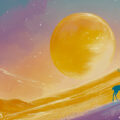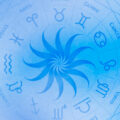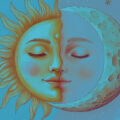Vedic Astrology can be sourced back to one of the six appendixes known as ‘The Limbs of the Vedas.’ Just as it is difficult to pinpoint the time that the Vedas were first cognized, it is also challenging to decipher the moment that Vedic astrology was born, though it is thought to have begun sometime between 1500 and 2000 BC.
Astrology is considered to be the eyes of the Vedas due to its ability to help us see our lives more clearly. As a ‘science of light’ its intention is to remove darkness, or ignorance. The great sages of Vedic Astrology, of which Maharishi Parashara was the most influential, shared knowledge of astrology as a means to gain self-knowledge and self-realization. The astrological birth chart shows the exact karma that the soul has chosen to experience in this life in order to continue its evolution.
Vedic Astrology is greatly concerned with the timings of events. In the same way that a farmer assesses the seasonal and weather cycles to determine when to plant seeds in order to yield the largest crop, astrology was, and still is, used as a tool to examine the cycles of time itself. It can be used to work out the ideal moment to begin a ceremony, event or project to achieve the best possible results.
Through the teachings of Vedic Astrology we can gain a wider understanding of the interconnection of everything from microcosm to macrocosm, and recognise and connect with the one underlying spirit, or consciousness.

The Source of the Vedas
Many thousands of years ago, the great sages, or Rishis, silenced their mind, sat in deep meditation, and ‘downloaded’ the scientific and spiritual wisdom that came to them. From atomic structure and mathematical calculations to the definitions of nature’s forces and the subtle realm of sound and vibration, the Rishis shared the knowledge that was revealed to them.
They were the scientists of the time whose calculations and scientific observations such as their description of molecular structure remain accurate even today, verified by the later discoveries made by Western science. The Rishis ability to hear or ‘see’ the knowledge in deep meditation gave them their title as ‘Seers’. Through their observations they were able to understand and describe the consciousness that permeates the entire creation.
An extensive body of knowledge was cognized by the Seers, and passed through the generations by word of mouth. It was later finally written down and compiled into the Vedas by Rishi Vyasa around 1500 to 500 BC. The result is an encyclopedia of knowledge covering the scientific and spiritual teachings of all aspects of life.

Rig, Sama, Yajur, Atharva: The Four Books of the Vedas
Coming from the root, ‘Vid, meaning ‘to know,’ Veda is a Sanskrit word that can be translated as ‘knowledge’ or ‘wisdom.’ The Vedas are made up of four books, Rig Veda, Yajur Veda, Sama Veda, and Atharva Veda.
🟠 Rig Veda is the oldest and best known of the Vedas and comprises 1028 hymns and 10,600 verses, organized in ten sections. It has within it the popular Gayatri mantra and Mahamrityunjaya mantra, along with other chants for health, happiness, wisdom and spiritual growth. It shines a light on deep topics such as the purpose of human life and the origin of the universe.
🔵 Sama Veda is the book of songs and mantra chants, focusing on the devotional music aspect. Instruction is given on how to play ancient musical instruments, and the sacred art of dance.
🟣 Yajur Veda instructs priests on how to honor the deities and perform ceremonies and rituals, including the correct way of chanting mantras.
🟢 Atharva Veda is a collection of chants, spells and prayers, and focuses on prolonging life by the healing of illness, as well as chants for marriage and cremation.
In general this Veda is focused on addressing the daily problems people experienced during Vedic times. Though there is also a mention of medicinal plants in the Rig Veda, the Atharva Veda is thought to be the main source of knowledge about Ayurveda, the holistic medical system and ‘science of life.’ It also includes topics such as dentistry and plastic surgery.
Each book of the Vedas teaches us that we, as human beings, are not independent entities but are part of one universal consciousness, and are reliant on the higher forces in creation. The rituals and knowledge help us to connect with these natural forces, which brings material prosperity as well as mental wellbeing and spiritual evolution.
The renowned spiritual leader, Gurudev Sri Sri Ravi Shankar, has shared that the Vedas were written in a language that pre-dated Sanskrit, and from which the Sanskrit language was derived. He stresses the importance of the vibrations of the chants, explaining that they are more important than the meaning itself.

From Mantras and Ceremonies to Karma and Liberation
The four books of the Vedas contain four types of text; The Samhitas, Arankayas, Brahmanas and Upanishads.
The Samhitas are the oldest part of the Vedas and are like a textbook containing mantras and chants that honor the divine. The Arankayas describe the details of rituals and ceremonies. The Brahmanas contain commentaries and deeper meanings of the rituals and ceremonies for priests. Upanishad means “sitting close,” referring to the position of mental closeness and humility required to receive knowledge from a teacher or Master. It includes teachings on meditation, philosophy and spiritual knowledge, including karma (right action), moksha (liberation or enlightenment) and the knowledge of the ultimate truth of existence.

Astrology in the Modern Era
The source of Astrology is incredibly ancient and yet its application remains significant to this day. Ever since the Vedic era, astrology has stood the test of time and, though our technologies and style of living may have changed, it is as practical and useful to us now as it was to the individuals and communities living in Vedic times.
Afterall, it is a science based on something that is so close to us that we often forget it’s even there – the sky above us. All we need to do is look up at the stars to be reminded of our place in the cosmos, and in the cycles of history.

























No Comments
Leave a comment Cancel